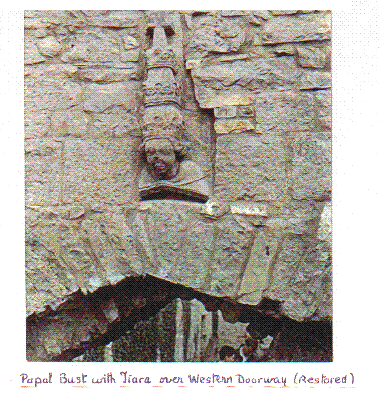The Franciscan Abbey
(Courtesy of Tom McGettrick; retired Principal National School teacher and local historian from Ballymote Parish)
"It is a pity there is so little known about Ballymote Abbey.Though destroyed about 1587, the Friars must have continued to teach school there, as two students taught at Ballymote were enrolled at Salamanca about 1691".
This is an extract from a letter written by T.H. Canon Quin, Parish Priest of Ballymote 1921-1943, on 24th September 1929, to a friar at the Franciscan House, Killiney, Co.Dublin. Histories of Sligo, published by this time, do not include any of the Abbey's story. J.C. McDonagh's History of Ballymote and Surroundings had not yet been published. He devotes some pages to piests, monks, and friars in the parish but he doesn't relate any of their activities to the story of the Abbey.
The Friary was founded in Ballymote in 1442 by three brothers; Patrick, Andrew and PhilipO'Coleman (O Colmain), of the Third Order of St. Francis. The tradition is that Pope Eugenius IV granted permission for the founding. The bust with papal tiara on the stone over the western entrance is regarded as acknowledging his association with the coming of the Franciscans to Ballymote. McDonagh, Chieftain of Corran, the barony in which Ballymote is situated, gave the Franciscans his patronage. He occupied the Norman-built castle near the sitee. Ballymote Castle changed ownership many times during its lifetime, depending on the fluctuating fortunes of the various factions that sought its shelter.
I had passed the Abbey many times down the years and saw only smothering ivy, scattered
stones and headstones in weedy surroundings, all adding their share of age and neglect to
the overall scene. At a more recent time a list of the guardians of the Friary in the 17th and
18th Century came my way and this caused me to think of what went on inside the walls
when the ruin was a roofed and windowed Friary sheltering a community of friars inspired
in their vocations by the rule of St. Francis of Assisi.
I am indebted to Fr. Ignatius Hennessy at Killiney for his help in tracing some history of the Ballymote Franciscans. He gave me a list of the guardians and a copy of Canon Quinn's letter. The information in available records tells of a community subjected to all the abuses that those who promote the Reformation and enforced the Penal Laws could heap on it. Sometimes local greed and rivalries brought trials their way. But when they were ruined or destroyed, as records tell, they held on or came back to repair and continue in their mission. There were gardens and orchards round their home and one and a half quarters of land, suggesting long periods of peaceful rural pursuits. It was then Ceathramha na Sagart, a name which was a recognition of the Franciscans long service there. Today it is the townland of Stoneparks.
In Medieval Religious Houses in Ireland, compiled by Aubery Gwynn and R. Neville Haddock, a paragraph on Ballymote Friary relates, "In 1483 Donald Oduda, master of the Franciscan House of Balemouta complained that Donatus MacDonkayd, a layman with accomplices attacked and burned the Friary and town driving the friars into exile and plundering them of their goods".
There is no reason given for this pillage and arson, which took place forty-one years after the Franciscans came to Ballymote.
McDonagh,Chieftain of Corran already mentioned(or his successor) had angered some local chieftains because of his aggressive efforts to lord it over them, and over his kinsmen, the McDonaghs of Tirerrill. Retaliation could have brought this fate on his town. This cannot be quoted as a historical fact. It might have been the plunder mentioned in Oduda's complaint,that drew the attack on the town and Friary.
That the Friars returned and put their house in order again is clear by the next event when the Friary is desecrated once more.The information is also from the source quoted above, 'An Inquisition of 1584-6 found that the Friary near the castle to which it belonged had been totally ruined by rebels'.The castle had been taken over by Sir Richard Bingham, English Governor of Connacht, and he placed his brother, George as constable over it.This Bingham made enemies of the O'Rorkes of Breffni( see O'Rorke's History of Sligo Pt.II).

